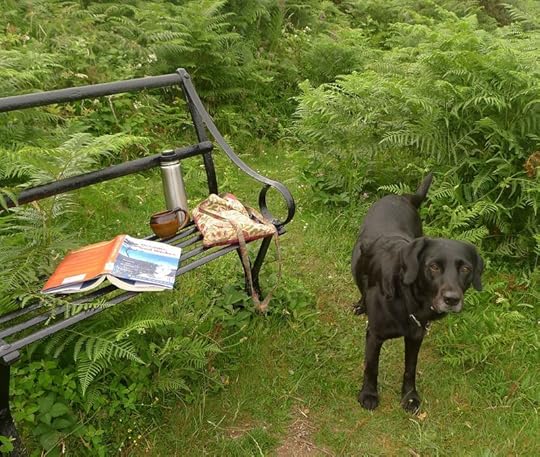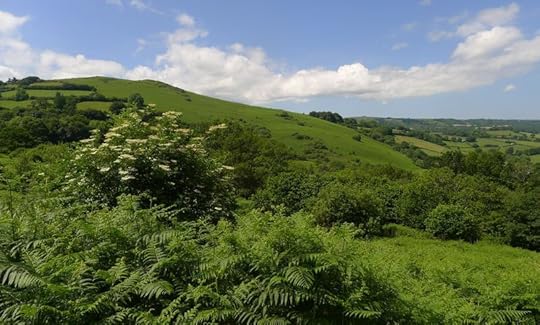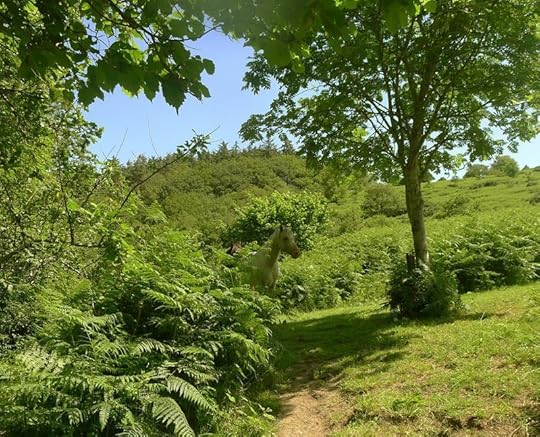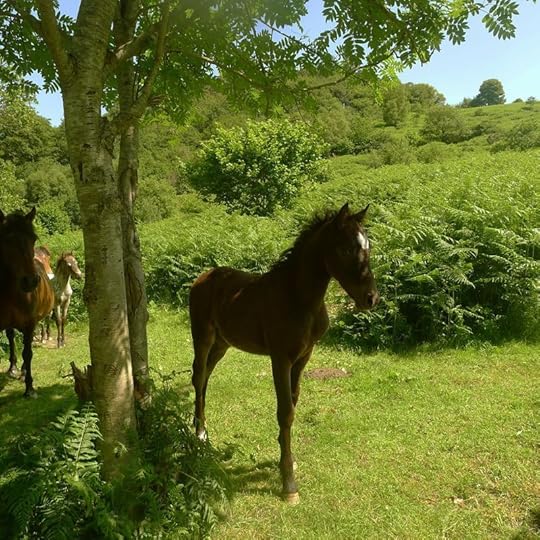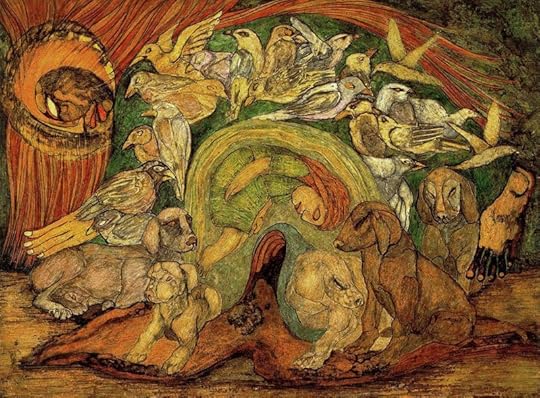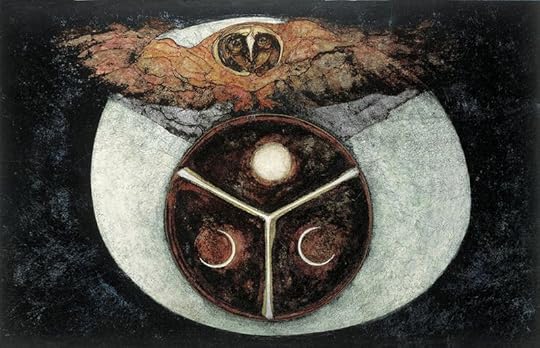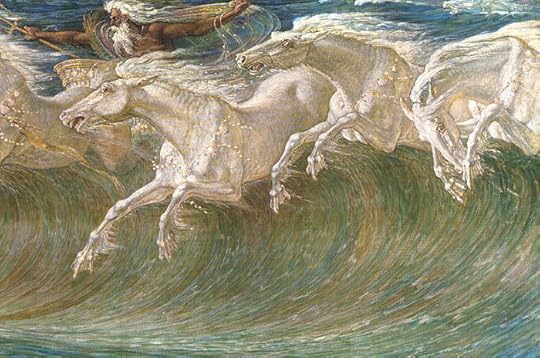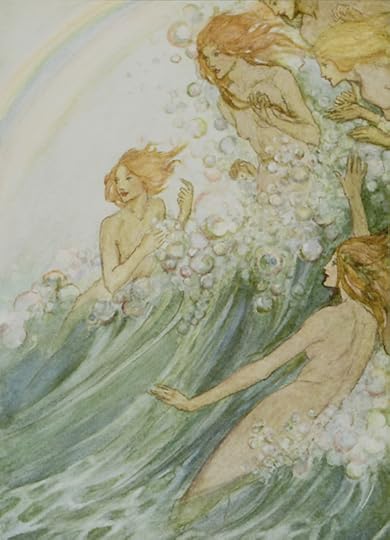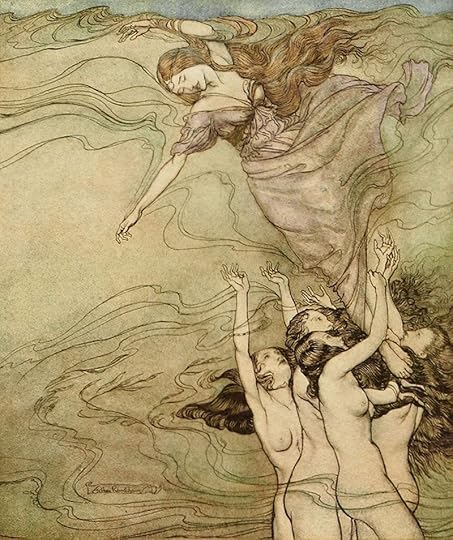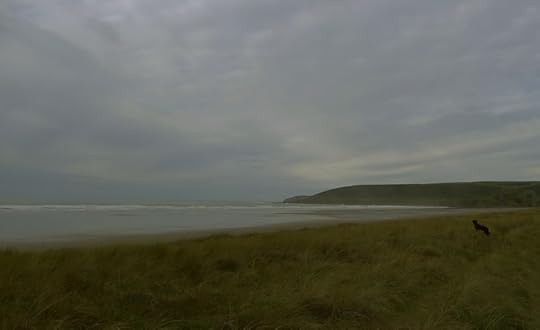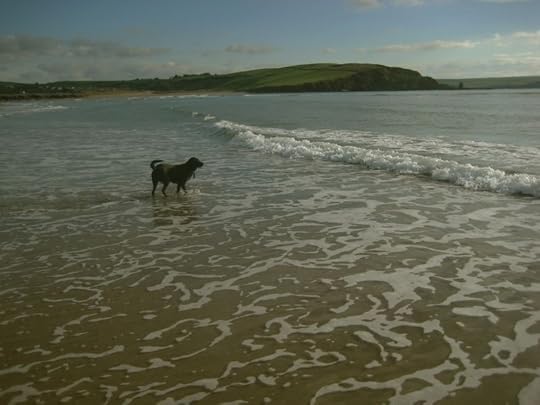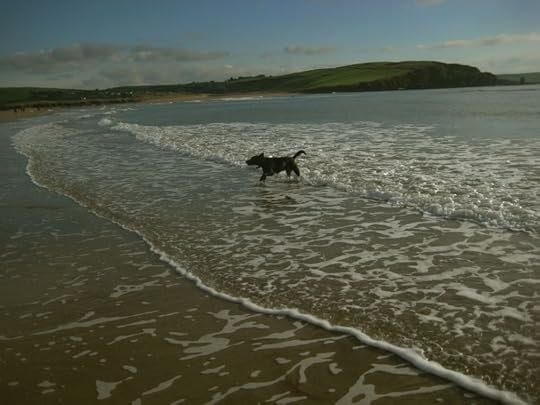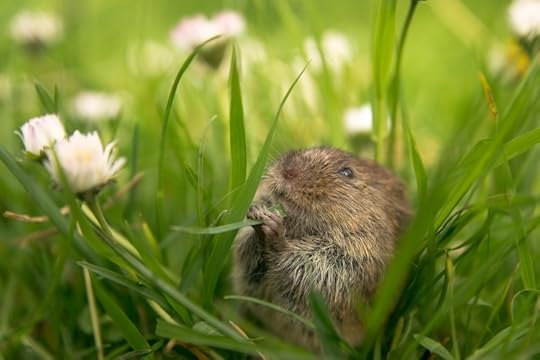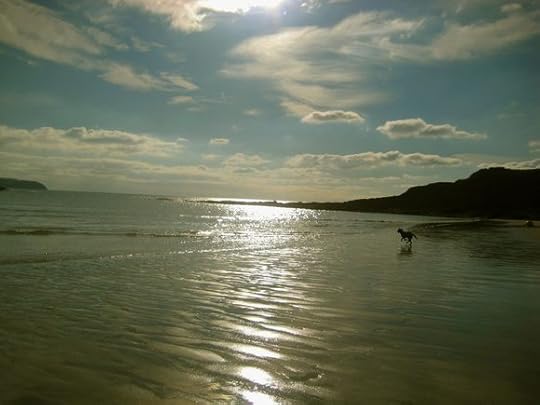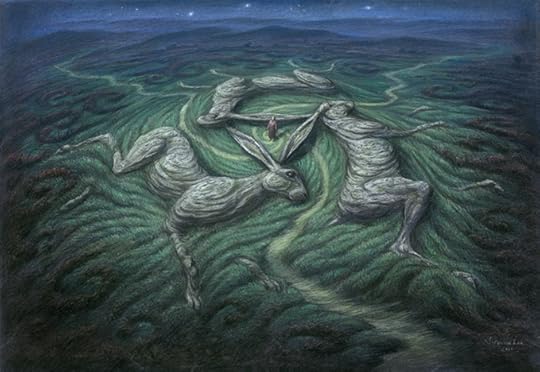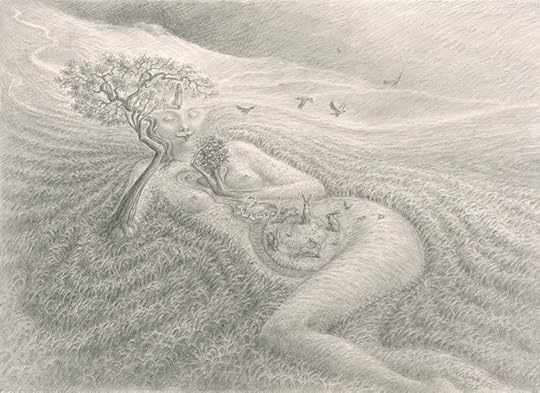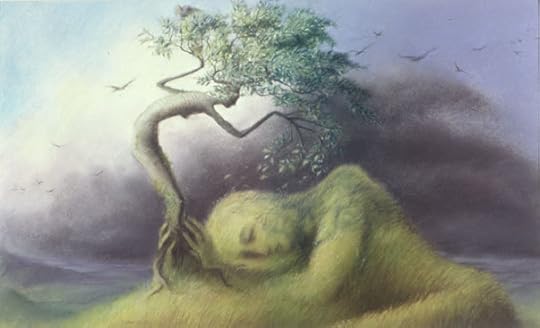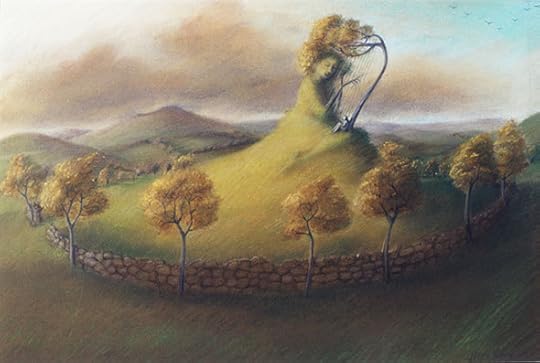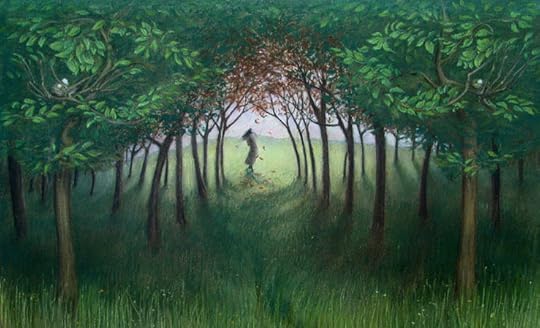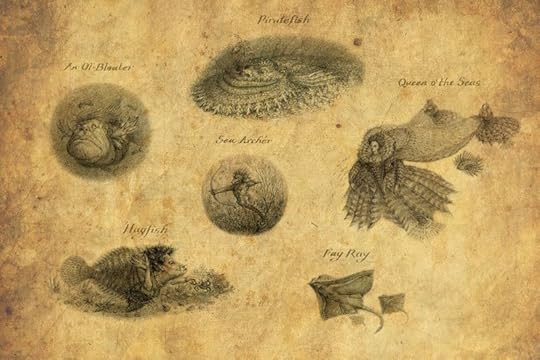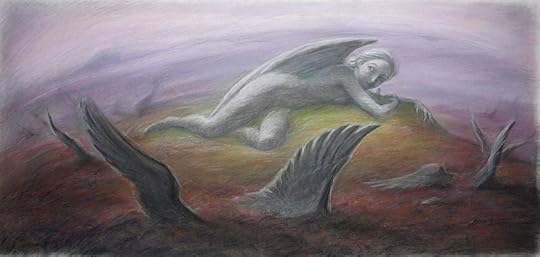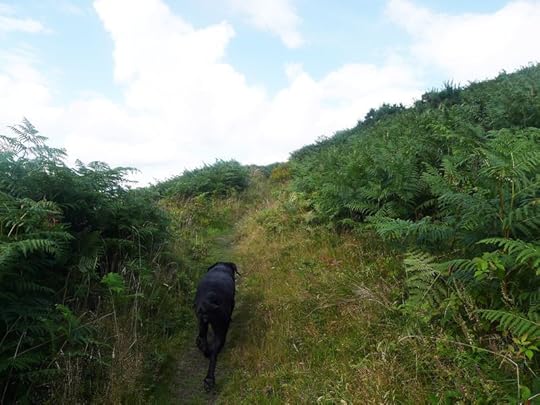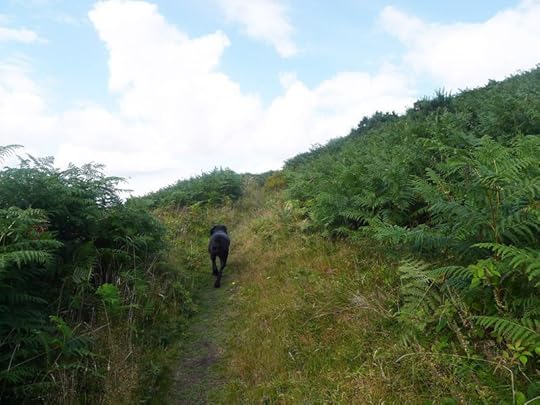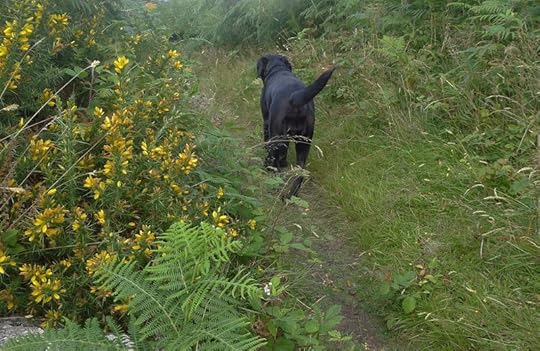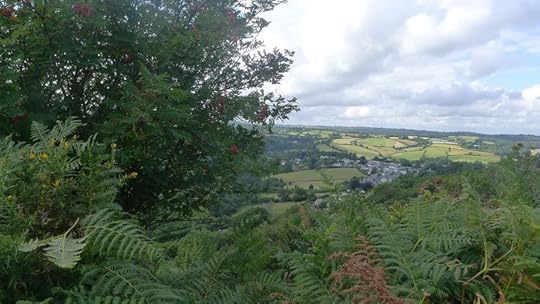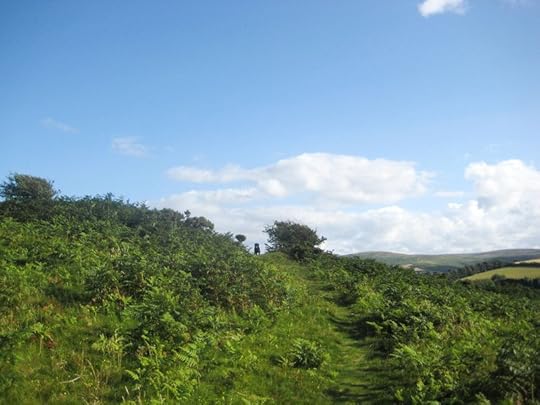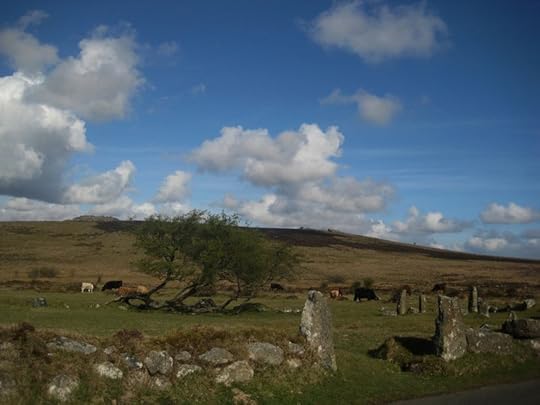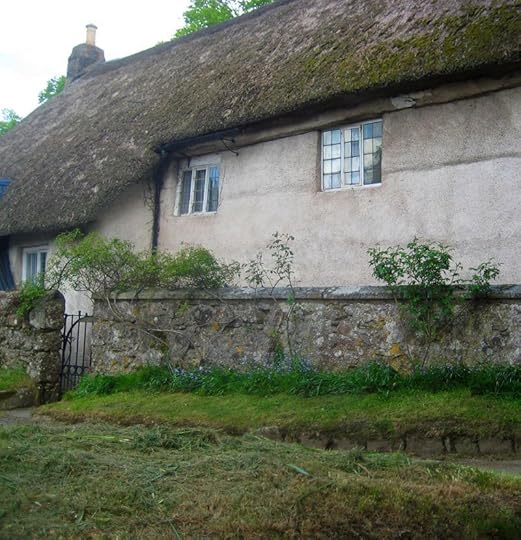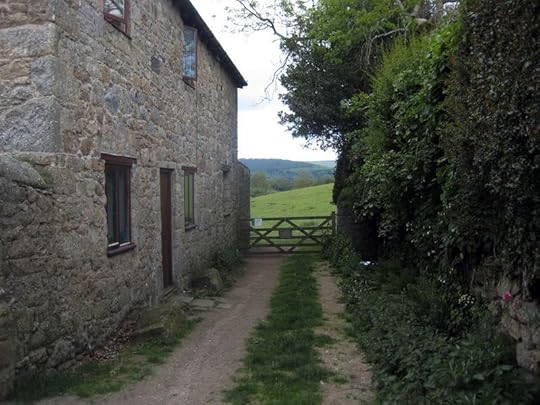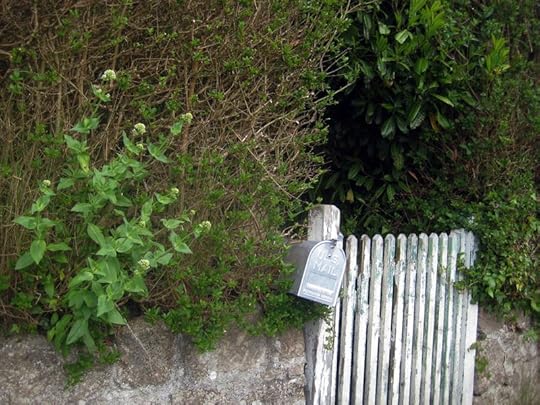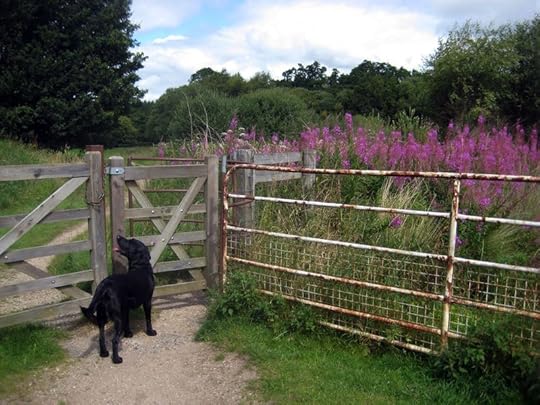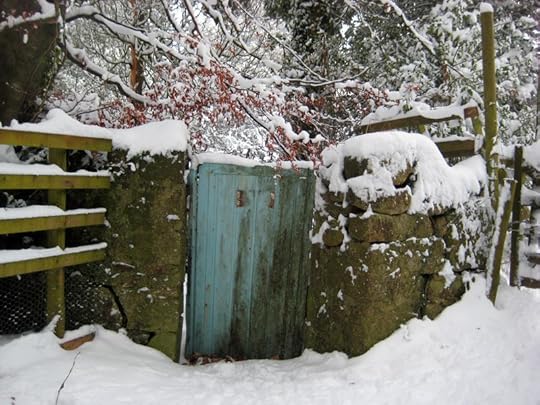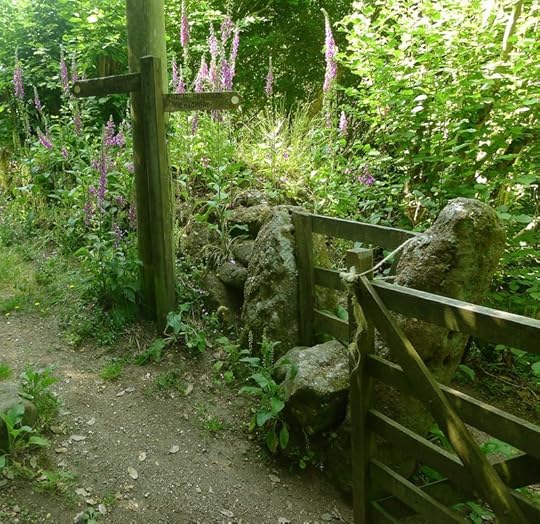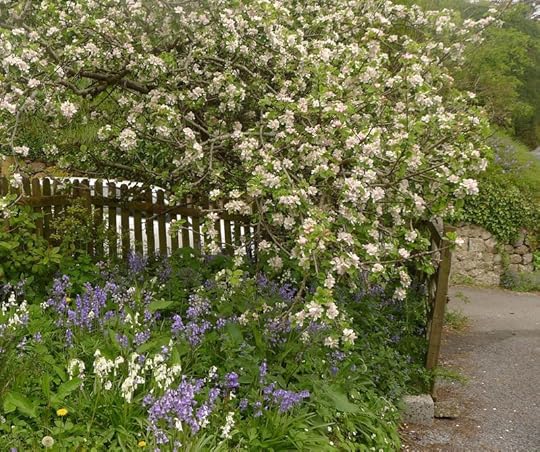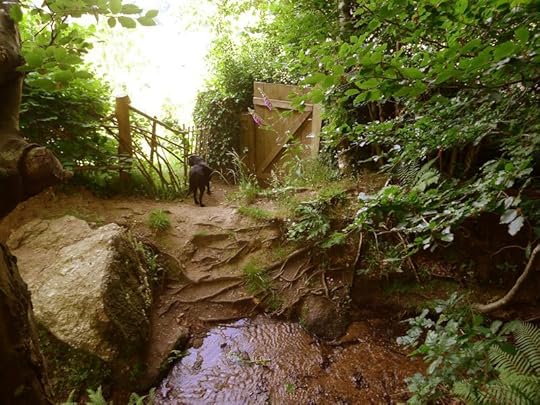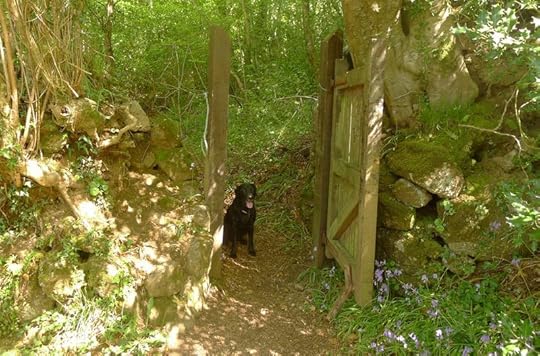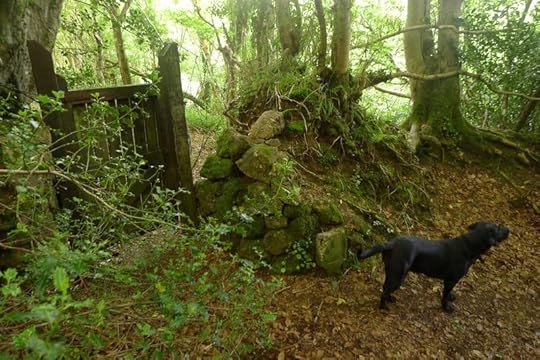Terri Windling's Blog, page 157
September 4, 2014
Neighboring lives
As I sat reading on the slope of Nattadon, with a thermos of coffee, Tilly beside me, and the fields of Chagford rolling in waves at our feet...
...Tilly turned with a growl, her tail held high in excitement mixed with alarm. Something was coming up the trail toward us. A walker? A dog?
"No barking," I murmured as she stood quivering, longing to do just that.
At this time of year bracken narrows the trails, turning them into tight tunnels of green, but at last our visitor stood revealed:
The large, gentle creature stopped and stared, just as startled by us as we were by her.
We often find cows at the bottom of the hill, grazing in the pasture below, but if they climb up the hill, they do it as a herd, not one one lonely cow on her own.
I looked up, and sure enough, the rest of the herd was high on the hillside above. "Let's move so that she can pass," I told Tilly as I gathered my things; then I led her down on a different path, her tail drooping with her reluctance.
Tilly perked up again when I passed by the homeward gate and took the streamside trail, leading to another good reading spot near a pool shaded by an old oak. But here, just as I was settling in, pouring fresh coffee into my cup, we heard a rustling in the tall bracken....
The wind? More cows? A neighbor's stray dog?
Out stepped a Dartmoor pony....
...no, a whole herd of ponies, young and old.
They were heading to the pool, intending to drink or to bathe...
...and we were in their way.
"Come on, girl," I told Tilly, laughing, "I give up. The hill belongs to our animal neighbors today. Let's go home and I'll get back to work."
So we did, and I did.
September 3, 2014
The Language of the Imagination: The Art of Meinrad Craighead
From A Field Guide to Getting Lost by Rebecca Solnit:
"In dreams I have been an eagle and a green finch, have met a three-headed coyote, wolves, foxes, lynxes, dogs, lions, songbirds, fish, snakes, cattle, seals, many horses and cats, some who talk, a woman giving birth by cesarean to a full-grown stag that ran away, still wet with the juices of birth, down a dark, tree-shrouded road, a gazelle fawn that a woman breast-fed, a brown bear who married a woman. 'They are all beasts of burden in a sense,' Thoreau once remarked of animals, 'made to carry some portion of our thoughts.'
"Animals are the old language of the imagination; one of the ten thousand tragedies of their disappearance would be a silencing of this speech. A man once told me that much of my writing was about loss, that that was how I imagined the world, and I thought about that comment for a long time. In that sense of loss two streams mingled. One was the historian's yearning to hang onto everything, write everything down, to try to keep everything from slipping away, and the historian's joy in retrieving out of the archives and interviews what was almost forgotten, almost out of reach forever. But the other theme is the common experience that too many things are vanishing without replacement in our time. At any given moment the sun is setting someplace on earth, and another day is slipping away largely undocumented as people slide into dreams that will seldom be remembered when they awaken. Only the continuation of abundance makes loss sustainable, makes it natural."
The powerful images here are by Meinrad Craighead, a visionary artist based in New Mexico. To quote her biography:
"She has spent her life exploring in art the human-divine relationship, particularly in images of God as the Great Mother. Her work portrays in vivid color both an active visual dialogue with God and a keen sense of the brooding, watching, beckoning power she finds in the land around her, in the sky above, the earth below, in the animals, in our dreams....Subjects in Craighead's work range from the visions of the Catholic women mystics to images of the Rio Grande, scenes from the psalms and the 'Song of Songs,' figures from Greek and Norse mythology, Native American animal and divine spirits, wise grandmothers, angels clicking castanets, otherworldly beings. There are also women giving birth in a variety of ways, self-portraits, menstrual blood, icon-like scenes featuring dogs, crows, flickers, coyotes, magpies, turtles, and owls."
To see more of her art, visit her website and seek out her books (Crow Mother and God Dog, The Litany of the Great River, The Sign of the Tree, The Mother's Songs, and The Mother's Birds). In the video below (a preview of a documentary on Craighead), she discusses her work and her artistic process.
The paintings above are "The Enclosed Garden," "Entering the 9th Cycle," " "The Grandmother," "When Artemis Hunts," "Moon Tree," and "Wisdom." All rights reserved by the artist.
The language of the imagination
From A Field Guide to Getting Lost by Rebecca Solnit:
"In dreams I have been an eagle and a green finch, have met a three-headed coyote, wolves, foxes, lynxes, dogs, lions, songbirds, fish, snakes, cattle, seals, many horses and cats, some who talk, a woman giving birth by cesarean to a full-grown stag that ran away, still wet with the juices of birth, down a dark, tree-shrouded road, a gazelle fawn that a woman breast-fed, a brown bear who married a woman. 'They are all beasts of burden in a sense,' Thoreau once remarked of animals, 'made to carry some portion of our thoughts.'
"Animals are the old language of the imagination; one of the ten thousand tragedies of their disappearance would be a silencing of this speech. A man once told me that much of my writing was about loss, that that was how I imagined the world, and I thought about that comment for a long time. In that sense of loss two streams mingled. One was the historian's yearning to hang onto everything, write everything down, to try to keep everything from slipping away, and the historian's joy in retrieving out of the archives and interviews what was almost forgotten, almost out of reach forever. But the other theme is the common experience that too many things are vanishing without replacement in our time. At any given moment the sun is setting someplace on earth, and another day is slipping away largely undocumented as people slide into dreams that will seldom be remembered when they awaken. Only the continuation of abundance makes loss sustainable, makes it natural."
The powerful images here are by Meinrad Craighead, a visionary artist based in New Mexico. To quote her biography:
"She has spent her life exploring in art the human-divine relationship, particularly in images of God as the Great Mother. Her work portrays in vivid color both an active visual dialogue with God and a keen sense of the brooding, watching, beckoning power she finds in the land around her, in the sky above, the earth below, in the animals, in our dreams....Subjects in Craighead's work range from the visions of the Catholic women mystics to images of the Rio Grande, scenes from the psalms and the 'Song of Songs,' figures from Greek and Norse mythology, Native American animal and divine spirits, wise grandmothers, angels clicking castanets, otherworldly beings. There are also women giving birth in a variety of ways, self-portraits, menstrual blood, icon-like scenes featuring dogs, crows, flickers, coyotes, magpies, turtles, and owls."
To see more of her art, visit her website and seek out her books (Crow Mother and God Dog, The Litany of the Great River, The Sign of the Tree, The Mother's Songs, and The Mother's Birds). In the video below (a preview of a documentary on Craighead), she discusses her work and her artistic process.
The paintings above are "The Enclosed Garden," "Entering the 9th Cycle," " "The Grandmother," "When Artemis Hunts," "Moon Tree," and "Wisdom." All rights reserved by the artist.
September 2, 2014
Tempering the spirit
From Holy the Firm by Annie Dillard:
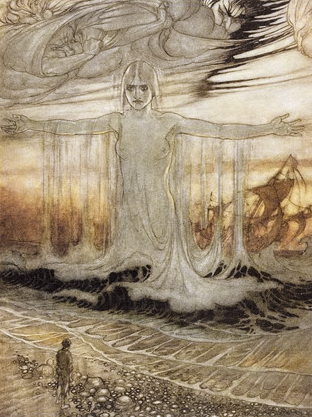 "Every day is a god, each day is a god, and holiness holds forth in time. I worship each god, I praise each day splintered down and wrapped in time like a husk, a husk of many colors spreading, a dawn fast over the mountains split....
"Every day is a god, each day is a god, and holiness holds forth in time. I worship each god, I praise each day splintered down and wrapped in time like a husk, a husk of many colors spreading, a dawn fast over the mountains split....
"I open my eyes. The god lifts from the water. His head fills the bay. He is Puget Sound, the Pacific; his breast rises from pastures ; his fingers are firs; islands slide wet down his shoulders. Islands slip blue from his shoulders and glide over the water, the empty, lighted water like a stage.
"Today's god rises, his long eyes flecked in clouds. He flings his arms, spreading colors; he arches, cupping sky in his belly; he vaults, vaulting and spread, holding all and spread on me like skin."
"I came here to study hard things -- rock mountains and sea salt -- and to temper my spirit on their edges...[And what I face is] sea, and unimaginable solid islands, and sea, and a hundred rolling skies. You spill your breath. Nothing holds; the whole show rolls....Land is a poured thing and a time a surface film lapping and fringing at fastness, at a hundred hollow and receeding blues."
"Here is the fringey edge; where elements meet and realms mingle, where time and eternity spatter each other with foam.
"The salt sea and the islands, molding and molding, row upon row, do not quit, nor do winds end nor skies cease from spreading in curves. The actual percentage of land mass to sea in the Sound equals that of the rest of the planet: we have less time than we knew. Time is eternity's pale interlinear, as islands are the sea's. We have less time than we knew and that time is bouyant, and cloven, luscent, and missile, and wild."
 The illustrations above are by Walter Crane, Arthur Rackham, and Florence Harrison. (See the picture captions for individual credits.) The photographs are not of Puget Sound, but of sea-loving Tilly on the Devon coast.
The illustrations above are by Walter Crane, Arthur Rackham, and Florence Harrison. (See the picture captions for individual credits.) The photographs are not of Puget Sound, but of sea-loving Tilly on the Devon coast.
September 1, 2014
Wildlife in Britain
The British Wildlife Photography Award winning pictures are always awesome. Go here for a gallery of the 2014 winners, and be sure to check out the Young Photographers Wildpix too.
 Photo credits are in the picture captions. (Role your cursor over the images.)
Photo credits are in the picture captions. (Role your cursor over the images.)
August 31, 2014
Tunes for a Monday Morning
Above, The Unthanks (formerly known as "Rachel Unthank and the Winterset") perform "Monday Morning" in a pub in Sydney, Australia (2010). The Unthanks, formed by sisters Rachel and Becky Unthank, play the folk songs of northern England blended with jazz and other musical genres. Their latest album is Songs of the Shipyards.
Below, singer-songwriters Bella Hardy and Cara Luft team up to perform "Time Wanders On," recorded in Canada for the EFDSS and Folk Music Canada (2013). Hardy is a folk musician from Derbyshire, UK. Her latest album is Battleplan. Luft is a folk musician from Alberta, Canada, and a founding member of The Wailin' Jennys. Her latest album is Darlingford.
Next, the amazing Johnny Flynn performs "The Lady is Risen" in Cologne, Germany (2014). Flynn is a singer-songwriter from South Africa and Hampshire, UK, currently based in London. His latest album is Country Mile.
And last, Roddy Woomble and his band perform "Every Line Of A Long Moment" in Aberdeen, Scotland (2011). Woomble is a singer-songwriter from Ayrshire, Scotland, and the lead vocalist for the indie rock band Idewild. (The band's name comes from the quiet meeting place in Anne of Green Gables.) He has also recorded with many other folk musicians, including Kate Rusby, Karine Polwart, Kris Dever, and John McCusker. His latest solo album is Live in the Inner Hebrides.
August 29, 2014
The starting point
Here's a provactive question from Eleanor Cameron, excerpted from her fine essay, "A Writer's Journey":
"I have told more than once how much place means to me in the books I have lived with year after year and read again and again, place not as backdrop or as a background to be worked up in order to get on with the action. Place, for me, must be loved and known; it gives rise to the book and its characters so that the sense of it could never come if its place meant nothing, or I had not experienced it aesthetically and emotionally.
"I was sixteen when I experienced my uprooting from [my childhood home in] Berkeley, the wrenching from my own place when I was just beginning to be aware of how much that place meant to me. Is such an uprooting, which many a writer has been subjected to in a far more traumatic way than I, good for one's art or bad?
"Possibly good," Cameron continues, "because then one writes out of loneliness and unhappiness and longing for that place and the people one has left behind in ways not possible if one lives in it. For me, at least, memory of what has been lost is a better creator of vivid place than happy satisfaction in being in it, if there is to be a cutting edge to whatever emotions are aroused in one's protagonists and to whatever influence place has over them, coloring their moods and, therefore, very often directing their actions.
"I know, of course, that there are innumerable instances disproving a notion of what seems to work for me. Think of Proust and Emily Dickinson; no need for journeyings there....Virginia Woolf, living in London, wrote Mrs. Dalloway, a superb evocation of that city. Both Eudora Welty and Flannery O'Connor, living in their own towns in the [American] South all their lives, have written classic short stories about the South. E.B. White wrote Charlotte's Web while living right on his farm in North Brooklin, Maine, where he'd ached to be all those years in New York. Lucy Boston has lived in her cherished Norman manor house -- Green Knowe -- and gone on writing about it ever since she first bought it and had all the later excrescences torn away to reveal the ancient, original structure.
"But Virginia Woolf wrote a better novel than Mrs. Dalloway in To the Lighthouse, about a much-loved childhood summer place in Cornwall, opposite the Godrevey Lighthouse, when she was many miles and years away from the scene. Katherine Mansfield wrote her finest and most artistically truthful stories about her childhood home in New Zealand...when she was living in France, ill much of the time and unhappy.
"The whole matter is, certainly, a very personal one. Natalie Babbitt told me once that she does not write from the inside out at all, as those do to whom place means so much, but from the outside in, getting an idea and then creating place and characters to flesh it out. For her, apparently, the journey either to or away from some special, loved place does not signify in her writing as far as intensity of feeling is concerned. Louise Bogan, the poet, in a biography by Elizabeth Frank, is quoted as saying: 'The initial mystery that attends any journey is: how did the traveler reach his starting point in the first place?' "
I am defintitely a writer, like Cameron, whose work is rooted in place...though I have written in both modes: in response to the land below my feet, and out of longing for places where I am not. In this regard, I write from the inside out. And you? Where is your starting point?
The exquisite paintings and drawings here are by my friend and Chagford neighbor Virginia Lee, another artist deeply inspired by place. Please visit her beautiful website , delightful blog, and Etsy shop to see more of her work.
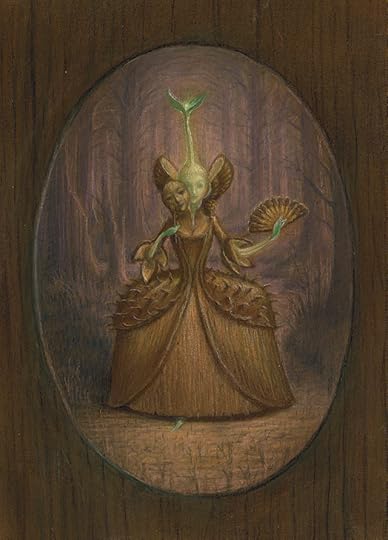 Eleanor Cameron's "A Writer's Journey" appears in The Seed and the Vision: On the Writing and Appreciation of Children's Books (1993).
Eleanor Cameron's "A Writer's Journey" appears in The Seed and the Vision: On the Writing and Appreciation of Children's Books (1993).
August 28, 2014
A walk on the hill
"Let us spend one day as deliberately as Nature, and not be thrown off the track by every nutshell and mosquito's wing that falls on the rails. Let us rise early and fast, or break fast, gently and without perturbation; let company come and let company go, let the bells ring and the children cry -- determined to make a day of it."
- Henry David Thoreau (Walden)
"Our lives are fittered away by detail....Simplicity, simplicity, simplicity!"
- Henry David Thoreau (Walden)
August 26, 2014
Lingering at the threshold
From Beauty by the Irish poet/philosopher John O'Donohue (1956-2008):
"The beauty of the earth is the first beauty. Millions of years before us the earth lived in wild elegance. Landscape is the first-born of creation. Sculpted with huge patience over millenia, landscape has enormous diversity of shape, presence and memory. There is a poignancy in beholding the beauty of landscape: it often feels as though it has been waiting for centuries for the recognition and witness of the human eye.
"In the ninth Duino Elegy, Rilke says:
Perhaps we are here in order to say: house,
bridge, fountain, gate, pitcher, fruit-tree, window...
To say them more intensely than the Things themselves
Ever dreamed of existing.
"We were once enwombed in the earth and the silence of the body remembers that dark, inner longing. Fashioned from clay, we carry the memory of the earth. Ancient, forgotten things stir within our hearts, memories of the time before the mind was born. Within us are depths that keep watch. These are depths that no words can trawl or light unriddle. Our neon times have neglected and evaded the depth-kingdom in favor of the ghost realms of cyberspace. Our world becomes reduced to intense but transient foreground. We have unlearned the patience and attention of lingering at thresholds where the unknown awaits us.
"The earth is not outside us; it is within: the clay from where the tree of the body grows. When we emerge from our offices, rooms and houses, we enter our natural element....There is something in our clay nature that needs to continually experience this ancient, outer ease of the world. It helps us remember who we are and why we are here."
Our love was born
outside the walls,
in the wind,
in the night,
in the earth,
and that's why the clay and the flower,
the mud and the roots
know your name.
― Pablo Neruda (from "Ode and Burgeonings")
"We do not want merely to see beauty...We want something else which can hardly be put into words - to be united with the beauty we see, to pass into it, to receive it into ourselves, to bathe in it, to become part of it. That is why we have peopled air and earth and water with gods and goddesses, and nymphs and elves.'' - C.S. Lewis (The Four Loves)
 Illustration by Arthur Rackahm (1867-1939)
Illustration by Arthur Rackahm (1867-1939)
Openings, entrances, reminders
One of the most gorgeous essays I've ever read is "(En)trance" by Chris Arthur (The Litery Review, 2008). It's a mediation on the entrance to the grounds of Shandon, his family's estate in Northern Ireland, consisting of two brick pillars (minus an iron gate that was melted down in World War II), a curved stretch of boundary wall, and the laurel thickets close by. Despite this tight focus, we are gifted with vivid flashes of Shandon's long history while also reflecting on the nature of time and myths of borders and edges...all so beautifully written that I felt breathless and a little light-headed when the essay was done.
Arthur, whose chosen form is the essay, compares himself to the kind of writer he'd assumed he would be when he was younger: a novelist; and thus "(En)trance" is also an exploration of the differences between these literary genres, and the ways that different writers might make use of the Shandon setting.
"Since writers of the sort I'm not aren't constrained by the boundaries of what happened, " he tells us, "it would be easy to invent all manner of stories about love and lust, about class and religion, about Englishness and Irishness, war and poverty....It's tempting to succumb to such diversions, to sweep through the pillars dramatically, making an entrance that draws the eye toward the unfolding of some vivid story, baited perhaps with rape or murder or the compelling simplicity of some other violently eye-catching beginning. But, for whatever reason, my interest is set in a key that eshews the racy harmonics of such narratives, even though I'm partial to them and often like to hum along.
"The entrances that intrigue me lead to less obvious destinations than the Big House with its cast of characters. For me, the pillars don't just suggest the domestic scale of a habitation and its dwellers. They also bring to mind pillars as ancient religious markers erected on the earth to make some claim to the numinous, to post a reminder of entrances beyond the obvious. These upright markers can be found scattered through the landscapes of many countries. Their style and date may vary; they may have been raised on the occasion of covenant, sacrifice, or worship. But for all their seeming variety, and despite their dense solidity, such pillars serve a similar fuction -- to act as apertures, bore holes, openings, entrances, reminders that mystery lies just beneath the crust of the quotidian.
"In Japan, the gates of shrines are guarded by pairs of stone dogs called koma-inu. These sit facing each other at either side of the entrance, creating an invisable barrier that visitors must cross. One dog has its mouth open; the other has its mouth shut. The one with its mouth open is breathing in and is called A. The one with its mouth closed is breathing out and is called Un. The phrase A-Un-no-kokyu ("A-Un breathing") has come to describe a relationship between people that's so close they can communicate without words.
"For me, invisable dogs stand at Shandon's pillars, their shared respiration symbolizing the intimate and mysterious connection that exists between the known and the unknown, between the telegraphic attenuations of the names we give things, the descriptions we offer -- superficial, partial -- and the significance that's coiled intricately within them. Passing between the pillars, I trip on this invisible unbilical of breathy connection and, as I fall, sometimes catch a glimpse of the endless sands of being upon which the mirages of common diction sparkle out their little images.
"We exist in a world of multiple registers that allow us to move through it in a variety of modes, but we sometimes forget the links between them. The no-nonsense world of facts and figures, at once useful and obscuring (perhaps useful because obscuring) skitters its way across the surface created by its own computations. Yet for every Un there is an A. Even if we are oblivious to it, in the breath of every sentence we inhale dormant complexities, their unnerving plenitude is only temporarily suspended by the icy hold of words; the promise of a thaw of complication-into-wonder remains whenever we pause for reflection."
You can read Arthur's essay in full in The Best American Essays 2009, edited by Mary Oliver and Robert Atwan (Mariner Books/Houghton Mifflin). All of the essays in this volume are excellent, but "(En)trance" is the stand-out. It's completely, well, entrancing.
At the entrance, my bare feet on the dirt floor,
Here, gusts of heat; at my back, white clouds.
I stare and stare. It seems I was called for this:
To glorify things just because they are.
- Czeslaw Milosz (from "The Blacksmith's Shop," translated from the Polish by the author and Robert Hass)
Terri Windling's Blog
- Terri Windling's profile
- 708 followers


